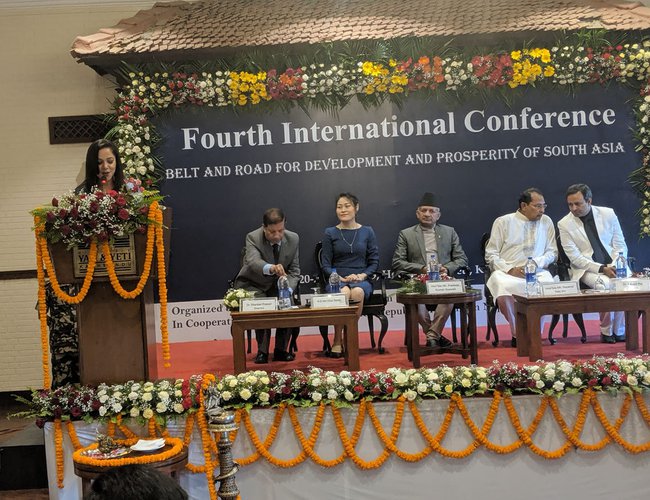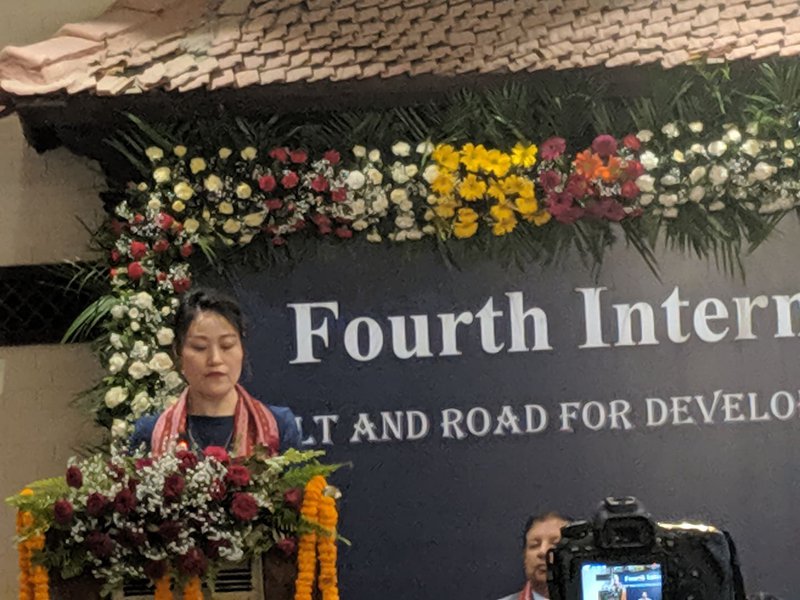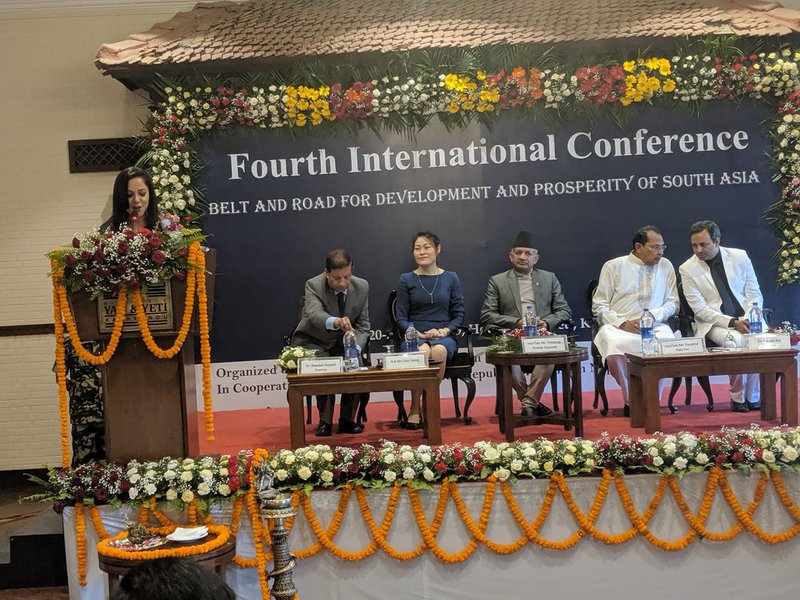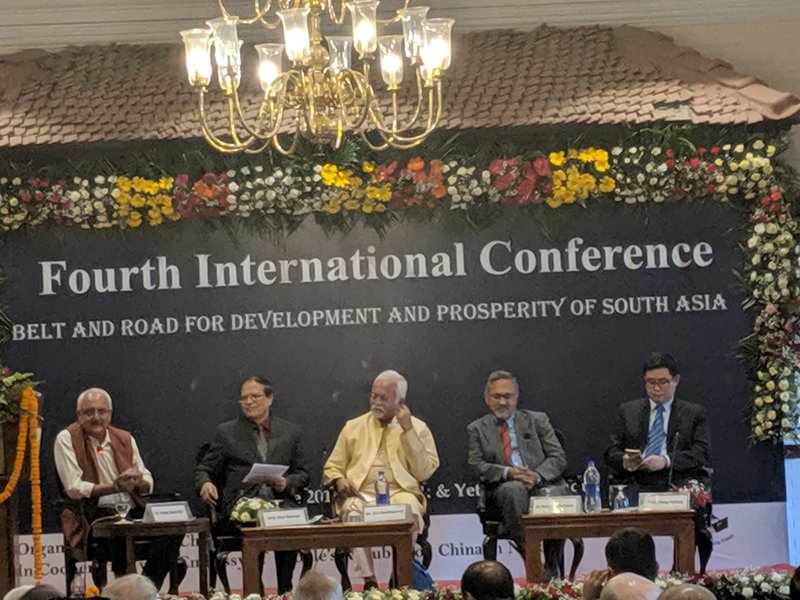
Minister for Foreign Affaiars Pradeep Kumar Gyawali inagurted the Fourth International Conference on Belt and Road (BRI) for development and prosperity of South Asia mid a function.
Addressing the program foreign minister Gyawali said that BRI has been helping the country of the region to achieve the economic growth. He said that Nepal attaches high importance to BRI and added that Nepal is preparing some project for BRI.
Chinese Ambassador to Nepal, Hou Yanqi said the South Asia region plays important role in the China-proposed Belt and Road Initiative.
"We want to have more meaningful cooperation with South Asian countries under the BRI framework. We are currently constructing the China-Pakistan Economic Cooperation and Hambantota Port in Sri Lanka," she said.
The Belt and Road Initiative follows the principle of mutual benefit, shared interests and win-win cooperation. "No countries have fallen into debt trap since China launched the BRI," she said.
From the chair, Dr. Shankar Prasad Sharma, former Vice-chairman, National Planning Commission of Nepal and former Ambassador of Nepal to the United States of America, said that Nepal needs to be very specific and result oriented choosing the BRI projects in Nepal. He said that Nepal needs to improve its existing road infrastructures to China adding Nepal can secure BRI to improve them.
Dr. Kalyan Raj Sharma, President, Nepal China Friendship Forum (NCFF), highlighted the importance of the project in his welcome remarks.
“The main objective of the conference is to bring together policy makers, experts, researchers, private sector and other relevant stakeholders to discuss dynamics of BRI to identify the opportunities it may bring to Nepal and South Asian countries for their economic development,” said Sharma.
“Our aim is to share country-specific BRI experiences from select South Asian and ASEAN countries to discuss ways for leveraging BRI for regional development in South Asia; and to identify workable modalities for implementation of BRI projects in SAARC Countries. to participants Participants of the conference will include cross-section of people from Nepal and South and Southeast Asian countries including representatives of government, ministries, diplomatic missions and academia,” said Sharma.
The two-day symposium brings together, among others, policymakers, researchers and businesses to build and enhance knowledge, interaction and network for greater understanding of the BRI initiative in the South Asia region. The conference shall delve on, inter alia, the developmental opportunities that the BRI brings to the SAARC region, including Nepal.
Different high level plenary were organized during the two day session.
Moderated by Kanak Mani Dixit, Founding Editor, Himal South, Belt and road for shared development and prosperity of South Asia Panelists included Prof. Atiur Rahman, Chairman, Unnayan Shamannay, Bangladesh and Former Governor of the Central Bank of Bangladesh, M. K. Bhadrakumar, former Diplomat, and Analyst, India, Dr. Surya Raj Acharya, Spokesperson, Sajha Bibeksheel Party, Prof. Zhang Jiadong, Director, Center for South Asian Studies, Fudan University, China.
Chaired by Gyan Chandra Acharya, former Foreign Secretary of Nepal, Darlene V. Estrada, Foreign Affairs Research Specialist, Centre of International Relations and Strategic Studies, Foreign Service Institute, Philippines , Dr. Nur Shahadah Jamil, Research Associate, East Asian International Relations (EAIR) Caucus, Malaysia, Vanxay Sayavong, Chief of Macroeconomic Monitoring and Forecasting Division, Centre for Macroeconomic Policy and Economic Restructuring (CMER), National Institute for Economic Research (NIER), Laos presented their paper.
Chaired by Dr. Posh Raj Pandey, Chairman, South Asia Watch on Trade, Economics and Environment (SAWTEE), Nepal, Prof. Di Fangyao, Director, Institute of South Asian Studies, Xizang Minzu University, Tibet Autonomous Region, China Presentation, Dr. Hina Aslam, Head of China Study Centre, Sustainable Development Policy Institute (SDPI), Pakistan, Dr. Mohammad Mahfuz Kabir, Research Director, Bangladesh Institute of International and Strategic Studies, Bangladesh presented the paper on BRI for trade and connectivity in South Asia.
Chaired by Kedar Bahadur Adhikari, Secretary (Commerce and supplies), Ministry of Industry, Commerce & Supplies (MoICS), Pranav Kumar, Head- International Trade Policy, Confederation of Indian Industry (TBC) Presentation, Dr. Wang Yuzhu, Director, Department of Regional Cooperation Studies, National Institute of International Strategy, Chinese Academy of Social Sciences, Beijing Presentation Yang Yabo, Associate Professor, South Asia Institute, Chinese Academy of Social Sciences, Tibet Autonomous Region, China Presentation, Prof. Mohammed Abu Eusuf, Professor & former Chair, Department of Development Studies, University of Dhaka, Bangladesh presented their papers.
What is BRI
The Belt and Road Initiative (BRI) was announced six years ago in 2013 as a project to build road and maritime routes linking China with multiple countries in Asia, Africa and Europe. So far, more than 150 countries and international organizations have signed agreements to be part of the Belt and Road cooperation with China.
A detailed explanatory document on the BRI has been issued on 10 May 2017, which mentions that China will “dovetail the BRI Initiative with the national strategies, development visions and general plans of countries along the routes to give the initiative the best possible start.” BRI calls for policy coordination, connectivity of infrastructures and facilities, unimpeded trade, financial integration, and closer people-to people ties.
In a recent BRI forum hosted in Beijing and attended by more than three dozen heads of state, President Xi Jinping reiterated China’s commitment of building "high-quality, sustainable, risk resistant, reasonably priced, and inclusive infrastructure" under the BRI. Context China is both a destination country for foreign investment and a major investor abroad.
The “six means of communication”—rail, highways, seagoing transport, aviation, pipelines and aerospace integrated information network—identified under the BRI comprise the main targets of infrastructure connectivity.
Nepal And BRI
As the neighboring region, South Asia is in a unique position to benefit from its immediate neighbor China. Along with Nepal, five South Asian countries share their borders to China. Nepal has a 1414 km long boarder with China in the northern side along the Himalayas. China is the second largest trading partner of Nepal. Nepal and China signed the Memorandum of Understanding (MOU) on cooperation under the BRI on 12 May 2017.
Following the signing of the MoU—during the visit of Nepali delegation to Beijing during the Second Belt and Road Forum for International Cooperation in April 2019—two countries signed, among others, the protocol for implementing the Transit and Transport Agreement which allows landlocked Nepal to use seven sea and land ports in China for its international trade. BRI has determined five routes for the Belt and Road to promote international cooperation. A framework including six corridors along these routes has been developed. Among the “six corridors” two engages the South Asia region: the China-Pakistan Economic Corridor (CPEC) and the Bangladesh-China-India-Myanmar Economic Corridor (BCIM-EC). Afghanistan, the Maldives and Sri Lanka also have been leveraging the BRI for their developmental needs.
The BRI, however, grapples with loads of criticisms from participating countries and others. The biggest of them is the risk of being trapped by high-interest Chinese debt. The study examined 3,485 BRI projects across 138 nations to conclude that BRI projects help narrow economic inequalities within host countries even if they risk tempting them into possible debt traps.



- Kathmandu Chronicle: Reclaiming India-Nepal Relations
- Apr 20, 2024
- India Provided Financial Support To Build Schools In Darchula
- Apr 20, 2024
- Iranians Protest After Attack
- Apr 20, 2024
- Weather Forecast: Light Rain Is Likely To Occur At Few Places In Koshi, Bagmati, Gandaki And Karnali Provinces
- Apr 20, 2024
- Japanese Ambassador Kikuta And DPM Shrestha Shared The Views to Deepen Nepal-Japan Bilateral Relations
- Apr 19, 2024
















